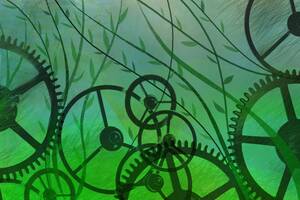Thus when social and physical scientists published in which they reported striking similarities in the way ecological and economic networks maintain stability, those who had sought evidence of commonalities applauded the results. Identifying general principles allows researchers to predict how networks in nature, in the financial sector, or in other domains might be strengthened.
Recently, an update on that 2009 study in Nature was posted online by the same authors: Brian Uzzi, a professor of management and organizations at the Kellogg School of Management; Serguei Saavedra, a postdoc at the Kellogg School; and Felix Reed-Tsochas of Oxford University. It is slated for publication as a chapter of a new volume in the book series Complex Systems and Interdisciplinary Sciences.
“What’s so original about their work is that it brings together two different fields—ecology and economics—by comparing the skeletons of their individual interactions,” says Jordi Bascompte, an ecologist at Doñana Biological Station in Spain. “It has us thinking about what common things make diverse systems stable.”
Uzzi and his colleagues analyzed long-standing ecological and economic networks using mathematical models. For each individual network, they looked at how specialized the players in the system were and how they interacted with one another. For insight on mutualistic relationships in ecosystems, they examined decades of data on plants and the insects that pollinate them in environments ranging from Japanese marshes to the Canadian tundra. And for economic systems, they referred to data on suppliers and contractors in the New York City garment district, a multi-organizational industry involved with making and buying clothes.
Long-Term Tips
Both systems play a central role in their respective environments, and both have been extensively documented. Garment district employees have recorded roughly 700,000 transactions occurring between 1985 and 2003. Data in hand, Uzzi and his colleagues took note of how many plant species an insect pollinated, how specialized a clothes supplier was in terms of its goods, and the variety of clothing a contractor requested, among other traits.
They then looked at these traits in terms of three general, overlapping properties of cooperative networks: degree distribution, modularity, and nestedness. Since many pollination and garment district networks have lasted over time, the authors looked to them as examples of stability. Thus, their characteristics indicate how networks are maintained in the long run.
A high degree distribution, the first property, means a bee contacted numerous varieties of plants or a contractor purchased clothing from hundreds of suppliers. Conversely, bees contacting a single species of plant or contractors working closely with certain suppliers were ranked as having a low degree distribution. On the whole, both networks were found to include a few high-degree players and many very low-degree players.
Uzzi relates this broad-scale pattern to Facebook. On the social media website, most members have around a hundred friends, but a few have tens of thousands. And the network may be all the more stable for that reason. If a member with one hundred friends cancels his account, it will not affect the network as whole.
“Networks tend to be robust to the killing off of animals in them, as long as those animals have a low degree of distribution,” Uzzi says. “Hitting high-degree individuals can break down a network very fast—so highly-connected individuals aren’t always good for the system.” For example, he adds, governments that censor expression over the Internet need only block Facebook and Twitter accounts of far-reaching members.
Modularity, the second property, has been a mainstay for engineers. Modular systems include non-overlapping subsets of components that interact with one another. With partitioned components, cars, computers, and robots need not fail if one of their systems falters. Here, the pollination and garment district networks follow a similar principle. In the case of the garment district, industries are modular when there are local communities within the global network, and the links among the firms in the local community are more interconnected than the links those same firms have to companies outside of the local community. If one community fails, the global garment industry does not go down with it.
Finally, the team found a connection between resilience and hierarchical, highly-nested systems. A system is considered highly nested if more of its relationships occur directly between individuals than through intermediaries. For example, twigs in a bird’s nest contribute stability based on the number of other twigs they touch and support. More one-on-one connections between twigs lend more stability to the nest.
With theoretical work, researchers have previously suggested that highly-nested ecological systems are more robust. If a plant has multiple one-on-one relationships with pollinators, it’s less vulnerable if one of its partners becomes scarce, because it has alternatives. As the number of interacting species goes up, the community theoretically becomes more robust to random extinctions or habitat loss. In the New York garment industry, the authors found that about 25 percent of the organizations were highly nested. In this setting, nestedness means a contractor works for a single designer rather than many.
Divided Labor
In certain cases, these three properties may deliver unexpected consequences. For example, if a system has a high degree of nestedness and modularity, it may maintain stability in the face of presumably negative forces, like freeloaders. In other words, freeloaders will get by in an otherwise smoothly-operating network. Why nature would allow freeloaders to exist unscathed remains a mystery, Uzzi says. “We have examples of free-riders in nature, such as snakes who mimic the colors of poisonous snakes but don’t put energy into actually producing chemicals,” Uzzi continues. “But before now, we didn’t understand this type of exploitation on a network level.”
Overall, the study suggests specialization is key to a resilient network, an idea that contradicts previous predications that systems of generalists are quicker to adapt and therefore more resilient. Instead, specialization appears to have benefits that are often overlooked. “Suppliers who primarily interact with one company of designers have more efficient interactions over time,” Uzzi explains. “They use fewer contracts and they are less likely to exploit one another. This added efficiency allows resources to be devoted elsewhere.”
Because these rules—broad degree distributions, high modularity, and high nestedness—generate stability in both plant-pollinator ecosystems and supplier-contractor garment industries, the authors say they’re likely to come into play in other domains. And by assessing weak points in various networks, researchers might learn what nodes need to be strengthened. “With the models we can ask whether an individual’s contribution to the network is positive or negative,” says Saavedra, a post-doctoral researcher in Uzzi’s group at the Kellogg School. “If we delete certain individuals in the model, we may find that the network is better off.”
Models of this sort could be applied to networks of banks, for example, to see if a more diversified banking system might be more resistant to collapse. Also, these models might help ecologists predict ecosystem vulnerability. Uzzi explains, “By figuring out which networks may be fragile, and what links are weakest, we can think about what we might do to help prop them up.”
Related reading on Kellogg Insight
Synchronicity Pays: Instant messaging helps traders buy and sell at the right time
The Price of a Billable Hour: Social networks affect transaction costs


